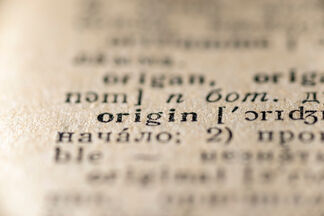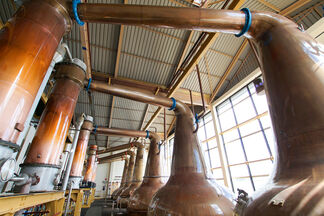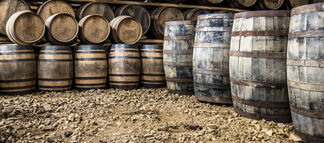
The Origin of Whisky
How Did Whisky Come to Be?
Whisky production has evolved and become more sophisticated over the years and my next Blog entry in a couple of weeks will talk about just that. But before we get there, I want to share with you the history of the core elements of whisky making. Where did they come from and how did they come together to form whisky?
Hopefully, you have read my Blog entry about how whisky is made. Well to look at where whisky came from, it may be worth another read. There are six steps in whisky making, but when we look at the origins of whisky, we can combine a few of them and look at 3 key parts of the process that have shaped whisky over the years. These are beer making, distillation, and storage (maturation). Whisky making certainly started and evolved from the art of making beer. The ingredients are similar (except whisky does not include the use of hops).

Beer Making
Whisky Certainly Stems From Beer Making
Beer is one of the oldest drinks humans have produced. The first chemically confirmed barley beer dates back to the 5th millennium BC in modern-day Iran, and was recorded in the written history of ancient Egypt and Mesopotamia and spread throughout the world.
As almost any cereal containing certain sugars can undergo spontaneous fermentation due to wild yeasts in the air, it is possible that beer-like drinks were independently developed throughout the world soon after a tribe or culture had domesticated cereal.
Hops became an ingredient of beer for two main reasons. One was to flavour the beer, but it was also to preserve it. Beer flavoured without it was often spoiled soon after preparation. The addition of hops to beer has been known at least since the 9th century, but was only gradually adopted because of difficulties in establishing the right proportions of ingredients. Before that, gruit, a mix of various herbs, had been used, but did not have the same preserving properties as hops.

Distillation
The Next Breakthrough in the Creation of Whisky
Beer has an alcohol content somewhere between 4% and 8% (there are some much stronger beers than 8% as you know!). To convert the basic beer used to make whisky involves distillation. Basically, distillation is the process of heating the base beer and collecting the steam – alcohol boils at a lower temperature than the rest of the beer. Whisky is distilled to a very high alcohol content (alcohol by volume, or ABV) of around 70% or 80% in some cases.
Early evidence of distillation was found on Akkadian tablets dated c. 1200 BC describing perfumery operations. The tablets provided textual evidence that an early primitive form of distillation was known to the Babylonians of ancient Mesopotamia, maybe as early as 3000 BC. Early evidence of distillation was also found related to alchemists working in Alexandria in Roman Egypt in the 1st century AD.
Distillation was was around way before whisky was even thought of and was used for other purposes. Distillation has many uses, among them water purification (de-salination and removal of contaminants) and the making of perfume. The earliest evidence of distillation for alcohol in Scotland is in 1494, at Lindores Abbey. We know this because of the earliest written reference to Scotch Whisky (or Aqua Vitae, as it was then known), which appears in the Exchequer Roll of the same year, naming Brother John Cor, a Lindores Abbey monk, who was commissioned by King James IV to turn 8 bolls of malt into Aqua Vitae. 8 Bolls of malt in modern terms would have been enough to make about 400 bottles of today’s whisky.

Casks
More Serendipity in the World of Whisky
Interestingly enough, the fact that whisky matures in oak casks was discovered by accident. In the olden days, wooden barrels were used merely as vessels for storing the freshly distilled spirit.
A lot of the spirit was consumed before it ever got the chance to evolve into anything that smelled or tasted like the whisky we drink today. Nevertheless, here and there some casks were left laying around long enough to mature. And gradually, it was realised that a whisky stored in a cask for a while was different, and better, than a very young spirit.
The history of casks begins in the 5th century BC when the Greek historian Herodotus talks of casks of palm-wine being shipped to Babylonia. However, it seems likely that the cask significantly pre-dates this and was first developed in the early Iron Age, around 800 to 900 BC, perhaps even earlier. Certainly the art of bending wood via heat-application had been used in boat-making for millenia and the existence of straightsided, open wooden buckets, employing the craft of the cooper, is documented in Egypt as early as 2690 BC.
It is not possible to say exactly who invented the cask because wooden artefacts do not survive well in the archeological record. The Celtic tribes of central and western Europe are potential candidates as they were skilled in metallurgy and woodcraft, and had acquired a love of wine making from the Greeks and Romans to the south. The Vikings have also been suggested, fond as they were of iron tools and surrounded by forests. It could even have been the brainchild of the ever-inventive Romans themselves. Certainly our word ‘cooper’ derives from the Latin ‘cupa’, meaning cask.
But it seems certain that the cask was originally created to transport wine and then was adopted by the whisky industry as a storage receptacle.
The Scotch Whisky Regulations 2009
It Took A Long Time Before the Industry was Regulated!
Following a European Commission release of regulations regarding high value spirits, the UK released regulations specifically for Scotch Whisky in 2009. The regulation is number 2890 and covers the minimum requirements for a spirit to be called Scotch Whisky. The trigger to do this was an export value in excess of 3 Billion Pounds. Until that point, regulations were not really in place, but the guidelines were strict within the industry.
The regulation includes things like:
- A minimum alcohol by volume content of 40%
- A minimum maturation period of 3 years
- Maturation in an oak cask
And much more!
-
Wrap Up
Serendipity
The origin of whisky comes from several un-connected sources coming together through history. Beer being the core component in its earliest form. Distillation being a process created for things other than alcohol, but applied to beer to create a spirit with a high alcohol content. And finally, the use of wine casks to store the spirit, which over time proved to improve the taste of the spirit and become whisky.
I hope you enjoyed this brief look at the origin of whisky - next time, I will share some of the twists and turns that whisky has undergone over the centuries to become the complex drink it is today. Feel free to leave comments or questions! I am always happy to discuss!!